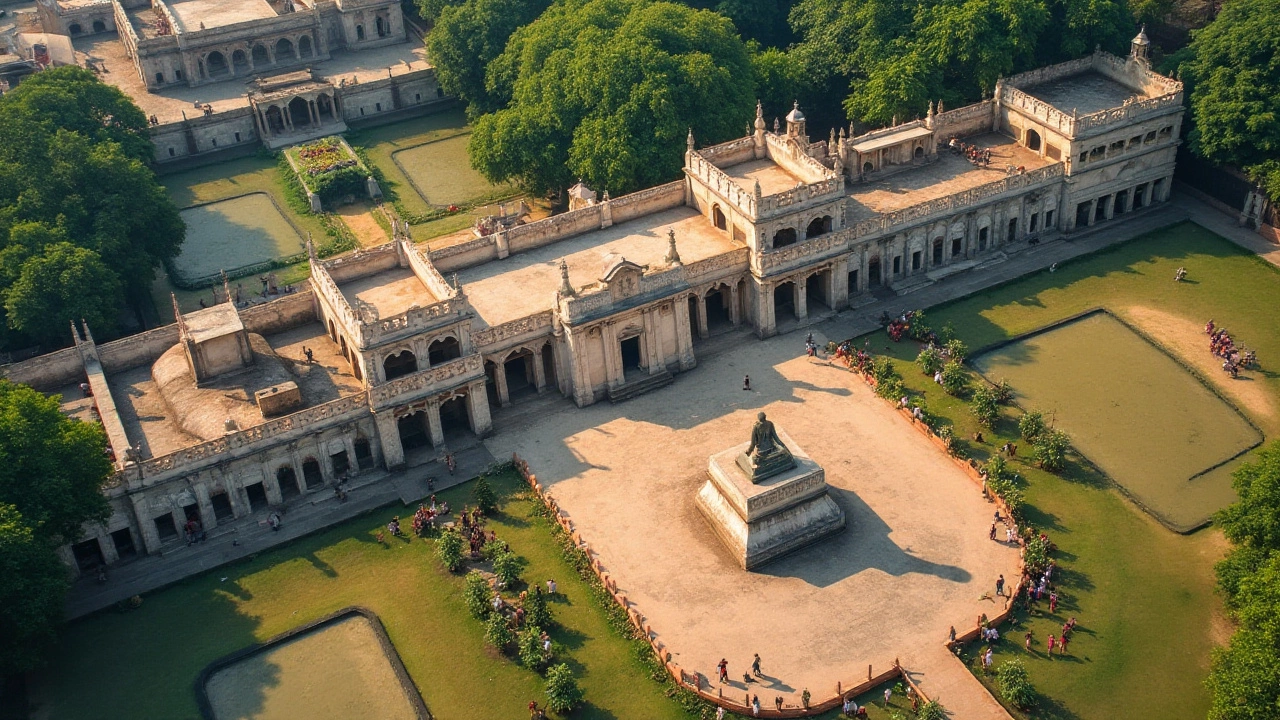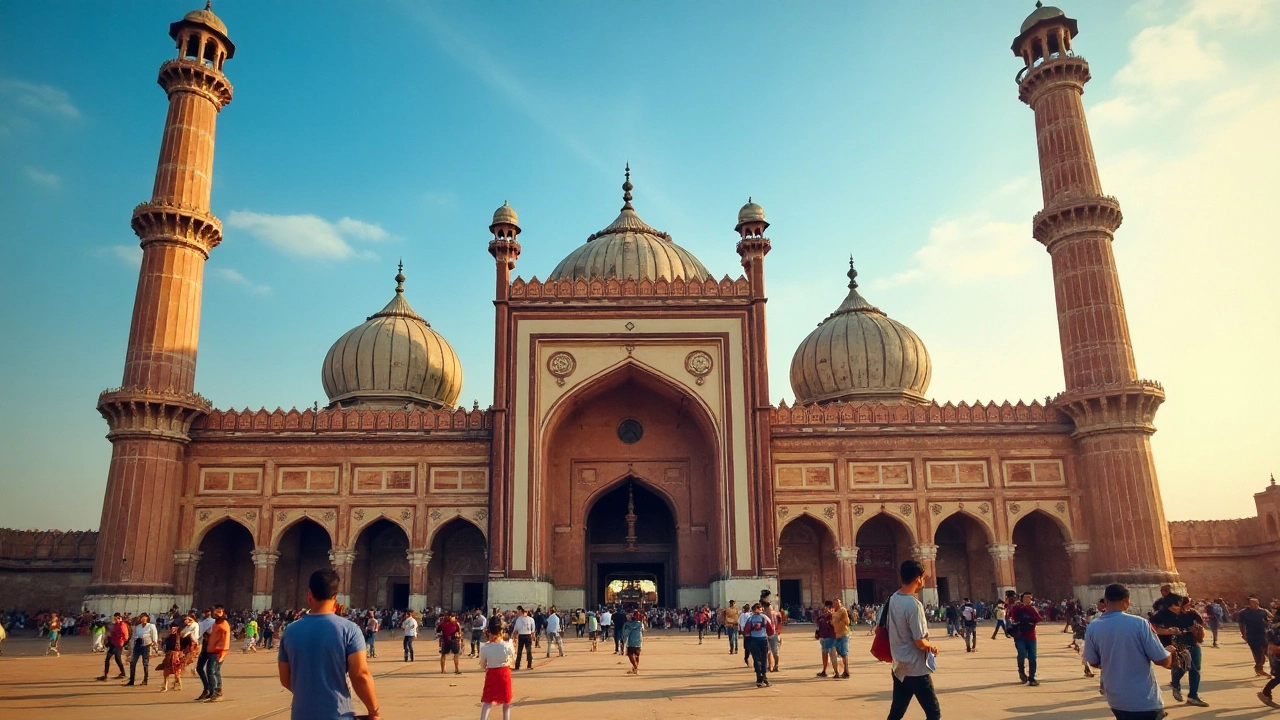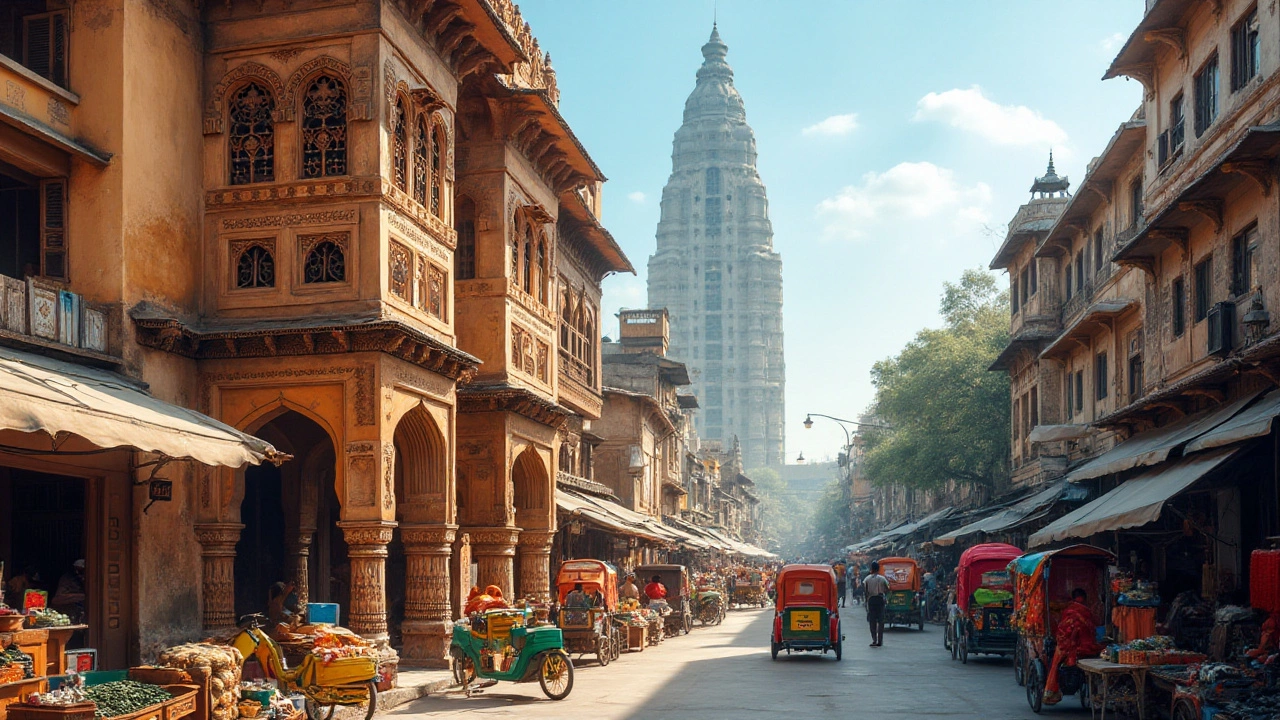Imagine a city where time has composed an intricate dance between history and modernity. Welcome to Ahmedabad, the first city in India recognized as a UNESCO World Heritage City. This vibrant city pulsates with culture, history, and architecture, unfolding stories from the past and the bustling life of the present.
Nestled in the western state of Gujarat, Ahmedabad boasts a legacy that traces back several centuries. It's a place where you can trace footsteps of ancient rulers in its age-old designs and savor the flavors of its rich cultural fabric. As you wander through its streets, you feel the whispers of the past mingling with the hustle of today.
In this article, we'll take a closer look into what makes Ahmedabad a captivating blend of old and new, enticing both history buffs and casual tourists. Whether it's your first visit or your fiftieth, there’s always a corner, a story, or an experience in Ahmedabad waiting to unfold.
- Ahmedabad: The Historical Canvas
- Cultural Melting Pot
- Architectural Marvels
- Living Heritage
- Visit Tips and Highlights
Ahmedabad: The Historical Canvas
Ahmedabad, a city that fits the definition of a living museum, is much like a woven tapestry where each thread narrates tales of dynasties, traders, and thinkers who left an indelible mark on its soil. Founded in 1411 by Sultan Ahmed Shah, this city has been a significant center for commerce, culture, and art, reflective of a glorious past. The Sultan's vision for Ahmedabad was one of a thriving metropolis that balanced the needs of commerce with the allure of artistry, making it an important hub in western India even back in those times.
The labyrinthine streets of the old city are strewn with remarkable structures. Among them is the Bhadra Fort, a majestic fortress that once housed royal palaces and expansive gardens, drawing visitors with its enigmatic past. As you delve deeper into the historic lanes, you encounter the Jama Masjid, an architectural masterpiece that stands as a testament to the city's Islamic heritage where believers gather beneath vast courtyards that echo with age-old prayers. This mosque, built out of beautiful yellow sandstone, reflects the true essence of Indo-Islamic architecture.
A well-respected historian once said, "Ahmedabad is where the past isn't just remembered; it has a vigorous heartbeat in the heart of the city." This sentiment is evident as one strolls past the intricate carvings of the Sidi Saiyyed Mosque, world-famous for its exquisite stone latticework, known as jali work, which has inspired artists for generations with its intricate and profound beauty.Living alongside these magnificent edifices are more than fifty 'pols,' the distinct residential clusters that are examples of community living and architectural genius. These pols are complete with carved wooden homes, secret passages, and even temples, portraying a vivid image of life as it stands still amid the rush of modernity. They aren't just neighborhoods but cultural relics that have stood the test of time.
The journey doesn't end with the grandeur of palaces and mosques. The city was once a flourishing center on the Silk Road, attracting traders from far-off lands who came in search of the finest textiles, spices, and precious stones. Ahmedabad's ancient textile mills are paramount to understanding its historic economic importance, marking it as a key player in the textile industry even today. These narratives of trade materialize in places like the Textile Museum, where visitors can appreciate the fashions that clothed kings and commoners alike through the ages.
Beyond the physical architecture, there are vibrant festivals, each pairing tradition with a sense of community. Events like Uttarayan, the international kite festival, are not merely cultural traditions but are living proof of how ancient practices have seamlessly blended into contemporary life. This makes Ahmedabad more than just a city; it is a symphony of traditions in practice.
| Name | Established | Style |
|---|---|---|
| Bhadra Fort | 1411 | Mughal Architecture |
| Jama Masjid | 1424 | Indo-Islamic Architecture |
| Sidi Saiyyed Mosque | 1572 | Stone Lattice Work |
Ahmedabad is not just captured in the history books but lives and breathes through its ongoing legacy. This city stands as a beacon for historical enlightenment, illuminating the paths of heritage and history with the triumphs and tribulations that crafted its identity over centuries. It is a place where one can walk shoulder to shoulder with Mahatma Gandhi in the peaceful expanse of the Sabarmati Ashram or bask in the serenity of its serene riverfront.
Cultural Melting Pot
Ahmedabad, shimmering on the banks of the Sabarmati River, is a testament to India's diverse cultural heritage. The city thrives as a fascinating blend of traditional and contemporary influences, where each neighborhood tells a story of centuries-old exchanges, invasions, migrations, and mingling. As you walk through its bustling streets, it's evident how cultures have layered upon each other, creating a unique urban tapestry that is distinctly its own.
The UNESCO World Heritage designation is not just a tribute to its stunning architecture but a recognition of its cultural profundity. A testament to this is its traditional markets like Manek Chowk, which morphs from a bustling bullion market in the morning to a thriving street food hub as dusk sets in. Here, the gastronomic offerings go beyond just taste sensations, reflecting a confluence of Hindu, Muslim, and Jain culinary traditions that have shaped the city's food culture over centuries. Each delicacy whispers tales of trade connections, conquests, and regional influences, making it more than just a meal but a bite of history.
But beyond material culture, Ahmedabad's soul is shaped by its festivals and celebrations, which are kaleidoscopic in participation and vibrancy. Navratri, Diwali, Eid, and the International Kite Festival are celebrated with equal fervor. The effervescent dance of Garba during Navratri, where thousands twirl in concentric rhythms, is not just an expression of devotion but a joyful merging of communities coming together in celebration. Perhaps this is best captured in a quote by the Nobel Laureate Rabindranath Tagore, who once proclaimed,
"In Ahmedabad, tradition and contemporaneity breathe and dance in perfect harmony".
Moreover, you cannot explore this World Heritage city without acknowledging the philosophical undercurrents of its cultural ethos. Ahmedabad was the crucible for India's independence movement, spearheaded by Mahatma Gandhi. Sabarmati Ashram stands as a silent witness to those transformative years. It draws visitors who seek not only to witness history but to reflect on the profound principles of nonviolence and simplicity that shaped a nation. The city's commitment to Gandhi's ideals is a living cultural narrative that continues to influence and inspire its residents and visitors today.
The cultural landscape of Ahmedabad also boasts a thriving arts and crafts scene. The city's artisans' skill has been passed down through generations, preserved and evolved through time. From intricately embroidered textiles to the unique block printing art known as 'Ajrakh', the local crafts are a mosaic of influences shaped by the confluence of trade routes and the patronage of various rulers. This dedication to preserving traditional crafts while embracing new forms of artistic expressions is reflected in cultural hubs like the renowned National Institute of Design, which acts as a bridge between tradition and innovation.
Indeed, Ahmedabad is much more than just a city; it's a celebration of diverse narratives, a place where every corner blooms with culture. From bustling bazaars that breathe history to festivals that unite hearts, and from architectural masterpieces to gentle philosophies, Ahmedabad invites everyone to experience its cultural kaleidoscope. It's a city where the past, present, and future converse, crafting a vibrant, ever-evolving symposium of human experiences.

Architectural Marvels
When one steps into the vibrant city of Ahmedabad, it’s hard to miss the exquisite blend of Islamic and Hindu architectural styles gracing its landscape. This city, a true gem of India, offers a visual treat through its architectural marvels, echoing centuries of regal heritage and cultural synthesis. Among these iconic wonders stands the Sidi Saiyyed Mosque, renowned for its intricate lattice window, the 'Jali', depicting the Tree of Life. Crafted in 1572 AD, the mosque is a symbol of finesse, with its delicate stone work that leaves visitors spellbound.
But Ahmedabad is not just about ancient mosques. The city is also home to the Mandir complex of the Hutheesing Jain Temple, which dates back to 1848. Commissioned during a time of famine by a wealthy merchant family, the temple is an epitome of philanthropy and artistic splendor. The temple's grandeur is augmented by its labyrinth of marble floors, finely carved pillars, and serene ambiance which offer a tranquil escape from the city's bustling life. It's fascinating how these structures invite you to touch the past while being firmly anchored in the present.
Exploring Ahmedabad, you'll also encounter Sabarmati Ashram, a site associated with Mahatma Gandhi, which offers a peek into India’s rich history of independence struggle. With simple yet profound architecture, the ashram appeals not by ornate designs but through its legacy of simple living and high thinking. And as you traverse these architectural narratives, you realize the rich tapestry of culture embedded in each stone and archway.
A noteworthy mention goes to the Adalaj Stepwell, a marvel not just in architectural genius but also in providing practical solutions to water scarcity in ancient times. Built in 1498, this five-story deep intricacy serves as both a work of art and a functional site. It retains cool air even during scorching summers. Rajput and Islamic styles intertwine here, creating a spectacle of columns, beams, and celestory openings.
These marvels of Ahmedabad go beyond just pleasing the eye. According to John Smith, a well-regarded historian, these sites are "a testament to the enduring human spirit and its unfaltering quest for beauty." The way different styles and epochs blend seamlessly in the architecture here reminds us that every building is a narrative—a tale told in bricks, stone, and latticework, detailing the past yet inviting everyone to dwell in its timeless elegance.
Living Heritage
The city of Ahmedabad isn't just about static relics of the past; it's a vibrant tapestry woven with the threads of its living heritage. Walking through the old quarters, known as 'Pols,' you can witness a lifestyle preserved through generations. These are not just residential areas; they represent a social structure where community living has thrived for centuries. Each Pol is a labyrinth of narrow lanes and intricately carved wooden facades, each telling stories of the families that have lived there for ages. The architecture mirrors that blend, with ornate balconies and internal courtyards fostering a sense of community unlike any other. Each door opens to a world of stories—of trades, crafts, and traditions that continue to thrive amidst urban landscapes. As you meander down these lanes, the past doesn't just linger; it thrives, carried forward by people who call these cultural pockets home.
One could say that the spirit of Ahmedabad lives in its people. It is a city that has embraced change yet fiercely holds onto its cultural roots. It is here that age-old festivals come alive with fervor and zeal. Whether it's the colorful Navratri dance or the vibrant Uttarayan kite festival, each event sees people of all walks of life coming together to celebrate. The sound of Garba drums echoes through the night as locals and visitors sway to their beats, while during Uttarayan, the sky is a riot of colors with kites of all sizes battling the winds. These traditions are not just perfunctory; they are a testament to the city's commitment to sustaining its cultural fabric.
At its heart, Ahmedabad is a melting pot, not just of cultures but of flavors as well. From street snacks that tantalize taste buds to culinary staples like Dhokla and Fafda, the city's markets and food stalls are an emblem of its culinary heritage. Traditional eateries that have stood the test of time serve up a smorgasbord of treats, each with a unique twist that speaks of innovations passed down through generations. In these local haunts, food becomes more than sustenance; it’s an experience, a journey into the heart of Gujarat’s savory tales.
An often overlooked aspect of Ahmedabad's heritage is its thriving arts scene. Artisans and craftsmen continue to preserve traditional crafts such as Bandhani and Zari weaving, passing skills down the family line. Markets like the Law Garden showcase a plethora of handcrafted items, reflecting the vibrant hues and textures of Gujarat. The city marries the traditional with contemporary arts, making space for both local crafts and international exhibitions. A unique initiative, the Ahmedabad Heritage Walk, offers you glimpses into these artistic corners, guiding you through a curated journey of the city's rich tapestry of sound, sight, and story.
"Ahmedabad is a dynamic city that honors its past while embracing the future," says a local historian. "Its living heritage is not just in its buildings; it pulses through everyday life here."
As you delve deeper into the living heritage of Ahmedabad, you realize that it is not just an ancient chapter of the past but an ongoing story. Richly diverse, it offers a dialog between generations, celebrating both the old and the new. To visit Ahmedabad is to step into a dialogue where history and today's narrative coexist, a confluence of life through stories told, retold, and lived every day.

Visit Tips and Highlights
When planning a visit to the UNESCO World Heritage City of Ahmedabad, a blend of meticulous planning and a spirit of spontaneity will serve you well. As the streets of this dynamic city unfold, you'll find the seamless tapestry of tradition and contemporaneity woven into every experience. Start your journey early in the morning to soak in the city's vibrant atmosphere and even catch the locals in their morning rituals. From brisk walk-throughs in bustling markets to quiet moments at historical landmarks, Ahmedabad should be embraced with flexibility and enthusiasm. Its open-hearted charm would invite you to take your time, savor the history, and engage with the culture deeply.
A visit wouldn't be complete without delving into the city's architectural marvels. The Sabarmati Ashram stands as a gentle guardian of the values that shaped a nation. A walk through this revered site transports you back to the time of Mahatma Gandhi, giving personal insight into his principles and work. While exploring, you might come across humble buildings that whisper tales of past ambitions, dreams, and the resilience of a people determined to forge their destiny.
Nearby, visit the intricately carved facades of heritage buildings in the old city areas like Ellis Bridge to Vadaj. The juxtaposition of such detailed old-world craftsmanship against the hustle of modern life is emblematic of Ahmedabad itself. The Pols, or historic neighborhoods, offer a glimpse of life rarely experienced elsewhere. The Urban Dharohar Foundation provides guided tours that unravel these gems in structured harmony, ensuring you don’t miss nuanced stories of triumph and tradition hidden within each corner.
Let your taste buds tag along for a tantalizing ride as Ahmedabad offers a gastronomic adventure. The local cuisine, with its plethora of flavors, is an essential aspect of Gujarati culture. Street food excursions offer more than just snacks; they serve a slice of local life. Savor khaman, soft dhokla, and spicy fafda at roadside stalls bursting with energy. As per Kunal Vijayakar, a renowned food critic, “A trip to Gujarat is half-baked without indulging in its street food. Each bite is a bit of humanity, served with a smile and plenty of flavors.”
Before you set foot in this historic city, consider the best times to visit. The cooler months from October to March reflect the city in the best light, both literally and metaphorically. The weather during this period welcomes visitors from around the globe, making it ideal for exploring outdoor sites. Carry comfortable shoes as most places are best enjoyed walking; this way, you'll catch unforeseen beauty with each step. The city is also well-connected by local transport, so plan routes that accommodate both common visits and spontaneous detours.
For those who thrive on detailed data, Ahmedabad played host to over 1.2 million tourists in 2022 alone. While the city bustles with energy, the heart of its charm lies in those intentional pauses beneath a centuries-old tree or alongside the tranquil Sabarmati River. This is a city of contrasts, and your visit should seek to embrace all sides of this multifaceted gem. Capture a moment of yourself with the cityscape, not just in pixels but in memories, as you take a piece of Ahmedabad back home with you.
